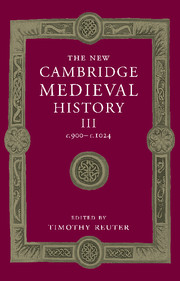Book contents
- Frontmatter
- 1 Introduction: reading the tenth century
- PART I GENERAL THEMES
- 2 Rural economy and country life
- 3 Merchants, markets and towns
- 4 Rulers and government
- 5 The Church
- 6 Monasticism: the first wave of reform
- 7 Intellectual life
- 8 Artists and patrons
- PART II POST-CAROLINGIAN EUROPE
- PART III NON-CAROLINGIAN EUROPE
- Appendix genealogical tables
- List of primary sources
- Bibliography of secondary works arranged by chapter
- Index
- Frontispiece
- Plate section
- Map 2: Archbishoprics and bishoprics in the early eleventh century
- Map 4: Germany
- Map 13: Byzantium in 1025
- References
2 - Rural economy and country life
from PART I - GENERAL THEMES
Published online by Cambridge University Press: 28 March 2008
- Frontmatter
- 1 Introduction: reading the tenth century
- PART I GENERAL THEMES
- 2 Rural economy and country life
- 3 Merchants, markets and towns
- 4 Rulers and government
- 5 The Church
- 6 Monasticism: the first wave of reform
- 7 Intellectual life
- 8 Artists and patrons
- PART II POST-CAROLINGIAN EUROPE
- PART III NON-CAROLINGIAN EUROPE
- Appendix genealogical tables
- List of primary sources
- Bibliography of secondary works arranged by chapter
- Index
- Frontispiece
- Plate section
- Map 2: Archbishoprics and bishoprics in the early eleventh century
- Map 4: Germany
- Map 13: Byzantium in 1025
- References
Summary
even though current historiography still preserves the concepts of ancient and medieval history devised in the nineteenth century, it is becoming steadily more apparent that these divisions – generally drawn up with political history in mind – are unsatisfactory for the historian of the economy or society. In these fields there is a longue durée from the decline of slavery in the third century to the first significant use of machine power in the eighteenth century. Nevertheless, undeniable developments in the techniques of production or in the relations between men force us to mark out certain stages in this long period, one in which Europe entered on the stage of world history. At what point was there a transition from the shrunken and undynamic structures still associated with Germanic or Graeco-Roman custom (the two were in this respect very similar) to structures in which the relationships between men and men and a production generating profits announced a more ‘modern’ economic climate? The question is not otiose; the answer will determine the view one takes on the ‘infancy of Europe’. In fact, almost all the observations which one can make, whatever the preoccupations of individual historians, point to the tenth century as the age of growth, of take-off, of rising, or some such phrase. In 898 we find the word feodum used in southern France to mean a tenancy by military service; in 910 the foundation of Cluny opened up a new phase in the history of spirituality; in 920 villages began to move on to hilltops in central Italy; in 955 the Magyars were definitively beaten; in 970 the series of commercial contracts surviving from Venice began; in 980 the gold of the Catalan parias arrived at Barcelona, and there are other similar examples from all spheres of economic activity.
Keywords
- Type
- Chapter
- Information
- The New Cambridge Medieval History , pp. 25 - 63Publisher: Cambridge University PressPrint publication year: 2000

